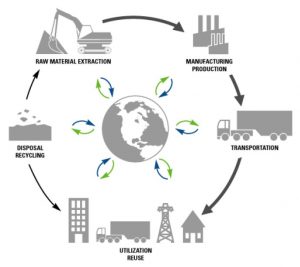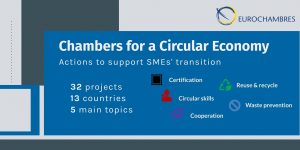Product life-cycle management (PLM) is the process of managing the entire lifecycle of a product, from A to Z, to avoid the worst consequences of mass production.

image source: https://en.wikipedia.org/wiki/Product_lifecycle#/media/File:Product%E2%80%99s_lifecycle.jpg
From inception, engineering, design and manufacture, to service and disposal of manufactured products, PLM integrates people, data, processes and business systems and provides a product information backbone for companies and their extended enterprise. PLM systems help organizations in coping with the increasing complexity and engineering challenges of developing a new competitive product, which process of production and negative effects on the environment, are just as important as the design of the product itself.
Linear Life-Cycle of a pruduct
Stage 1 – Product Development: The new product is introduced; this is when all of the research and development happens.
Stage 2 – Product Growth: The product is more than an idea or a prototype. At this stage, the product is manufactured, marketed, and released. Distribution increases, demand increases, and competition also increase.
Stage 3 – Product Maturity: During this stage, the product is widely available, and there are many competitors in the marketplace. You market the product to different segments, but more spending on advertising will have no impact on its demand.
Stage 4 – Product Decline: The product is losing market share, or becoming obsolete. It is well past its point of highest demand and the demand decreases.
The stages are influenced by the type of economy in which a products spends its life cycle.

image source: https://search.creativecommons.org/photos/9567653c-a052-4267-939f-9eeb398e787f by EUROCHAMBRES
closed-loop Life-Cycle of a pruduct
Inside the Circular Economy system, a closed-loop cycle is a natural extension of PLM and creates a truly full life cycle that turns used products back into raw materials, not just assigning them to waste. Although many of these closed-loop products are down-cycled (converted into lesser-quality materials), the products are still recycled and reused repeatedly.
An example of this is Dell’s take-back program, which takes the computers that it manufactures and turns a majority of them into new computers. The benefits of a closed-loop system include:
- Better for the environment
- Does not affect performance or price
- Fewer carbon emissions in manufacturing
- As programs scale, they become cheaper and more effective

image source: https://search.creativecommons.org/photos/c87ffd88-da0a-4e60-bf2c-7b02e6abbb41 by Oeko-Institut e.V.
info source: https://en.wikipedia.org/wiki/Product_lifecycle
